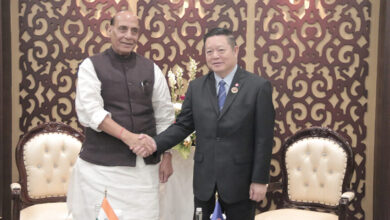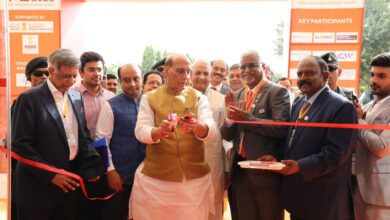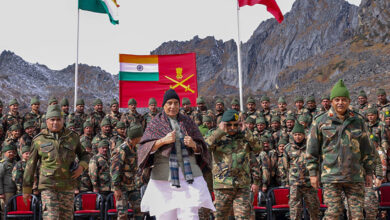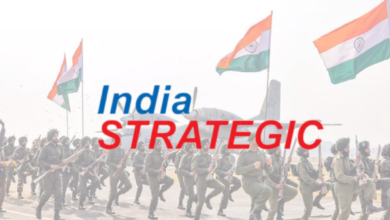The Paris Air Show: French Wine, Cabaret, Jet Speed, and the Indian Pie

The India market seems to be the focus at the Paris Air Show that opened here June 18 with global majors eyeing its huge civil and military aviation potential and with the country itself seeking export orders for an indigenously developed advanced light helicopter (ALH).
India’s Minister of State for Defence Production Rao Inderjit Singh, Indian Air Force (IAF) chief Air Chief Marshal F H Major, Defence Production Secretary K P Singh, Coast Guard chief Vice Admiral Rusi Contractor and top army, Navy, Air Force and Coast Guard officials are at the show to witness the displays and examine what can be useful for the Indian armed forces.
Hindustan Aeronautics Ltd (HAL) that builds the ALH has brought three of these machines here and hopes to market them abroad. Chile is already considering buying the ALH.
One of the ALHs conducted an impressive aerobatic display. HAL Chairman and Managing Director Ashok Baweja was also present here.
Paris. I have always been dazzled by Paris, a city close to my heart ever since my days in the Middle East when I had to travel frequently from Dubai to Algiers, Tunis, Casablanca or other North African cities; Air France provided the best connections and Paris, the best possible layover.
I didn’t know French but compiled a 4-page dictionary of spoken expressions, and thanks to the company of good French speaking friends in the Middle East, I did pick up the French accent reasonably well. I did some moonlighting for the French news agency AFP, and that too helped.
Visiting Paris for the Air Show, I noted that while Champs-Élysées stood for fragrance and short-skirted women, the air show at Le Bourget stood for both these plus jet speed in mega aviation deals. People worked overtime to forge business relations and wine, and sometimes cabaret, helped.
The booming India market was the focus at the air show with global majors eyeing its huge civil and military aviation potential on the one hand and India itself looking for some exports. In fact, I had done my first TV documentary on India’s modest defence export effort in 1995 aimed at exporting the indigenously developed advanced light helicopter (ALH) and Arjun Main Battle Tank (MBT).
Arjun of course has had teething troubles for long now, while the ALH, and a new formidable missile, the Indo-Russian BrahMos, are ready for exports.
The powerful BrahMos, which happens to be the world’s first supersonic anti-shipping cruise missile, is being offered though to a limited number of some Latin American and Gulf countries only. It was not displayed at Paris.
Nearly 2,000 participants from around 80 countries took part in the prestigious biannual air show.
 Among the leading Indian companies taking part were HCL, Satyam Computers and Tata Consultancy Services, all of whom had already signed major software networking contracts with international aviation companies like Boeing and Airbus.
Among the leading Indian companies taking part were HCL, Satyam Computers and Tata Consultancy Services, all of whom had already signed major software networking contracts with international aviation companies like Boeing and Airbus.
Minister of State for Defence Production Rao Inderjit Singh, who led the military side of the Indian delegation, inaugurated the HCL chalet, where details of the company’s latest agreements with Boeing for embedded software for its B-787 Dreamliner and with Smiths Aviation were disclosed.
HCL has already provided software for the British Royal Air Force (RAF) Nimrod surveillance aircraft and the massive Airbus A-380.
The stage for the mega deals was obviously set before the week-long air show began on Monday, 18th June and PR spinners from leading companies briefed their media friends well in advance. Raytheon, the company that provides the weapons punch to aircraft and ships, set the ball rolling with a Sunday brunch for the media on board a beautiful yacht.
Beer, wine, champagne, whatever one had, the river Seine reflected its sparkle. Host Torkel Patterson, Raytheon International’s President, sounded an optimistic note for India when he said that his company was willing to transfer its most secretive technologies provided the Indian and the US governments agreed.
He pointed out that while major US companies developed technologies for the American war fighter, their export was controlled and arms and expertise were transferred under the US Government’s Foreign Military Sales (FMS) programmed.
My question was specific to the Active Electronically Scanned Radar (AESA) radar as well as airborne and satellite borne surveillance sensors that are vital to modern warfare and security. The AESA capability in any case has been spelt out as vital by top Indian Air Force (IAF) officials, including former Chief of Air Staff S P Tyagi, for its requirement of new Medium, Multi Role Combat Aircraft (MMRCA), or just MRCA.
The radar is already on board the F 18 Super Hornet that Boeing is offering to India while, according to Patterson, Lockheed Martin has asked Raytheon to configure it for the F 16 also.
Gripen International’s Director for India Tony Ogilvy told India Strategic in New Delhi that his Swedish aircraft offered the best in technology which included Raytheon’s AESA radar, Israeli avionics and Beyond the Visual Range (BVR) missiles, and MBDA’s new generation Meteor Beyond Visual Range Air to Air Missile (BVRAAM) that is still under development but was tested recently from a Gripen.
 Ogilvy also said that Gripen had decided to upgrade the aircraft’s engine from GE 404 to GE 414, the same which is used by the twin-engine F18, and which HAL is also likely to buy for its upgraded Tejas Light Combat Aircraft (LCA).
Ogilvy also said that Gripen had decided to upgrade the aircraft’s engine from GE 404 to GE 414, the same which is used by the twin-engine F18, and which HAL is also likely to buy for its upgraded Tejas Light Combat Aircraft (LCA).
Boeing and Lockheed Martin also had India-specific briefings as the IAF should be releasing its RfP for 126 MRCA soon.
Northrop Grumman, which has a competing AESA radar operational on the UAE Air Force F 16s, declared that its technology had gone up by another generation as it had been able to use its AESA equipment for communication between pilots and ground control.
Grumman has offered India its highly sophisticated Hawkeye II for carrier borne intelligence operations. The Navy though is unlikely to buy it as it has no aircraft carriers to accommodate them.
The cocktail of French Wine, some cabaret, the sheer fragrance of Paris and expensive perfumes, and the well-organized air show, provided the right amount of ambience and jet speed to the six competitors to reach for the Indian pie, which could be anywhere from $ 7 to 15 billion, depending upon the numbers and weapons package.
The order is bound to go up to 200 or more, for the simple reason that IAF’s strength of existing aircraft is fast depleting. The process of newer inductions to match the pace of depletion will have to catch some time, and that would be possible only by acquiring a larger number outright from the winning manufacturer.
I was in Paris 10 days before the air show began, and again for a week after the show.
While the world made billions of dollars worth of deals, my eyes and ears were focused on India-specific business, and the interest of the visiting Indian military and civil aviation leaders.
Chief of Air Staff Air Chief Marshal Fali Homi Major and Director General of the Indian Coast Guard Vice Admiral Rustom Faramroze Contractor were at the show along with their teams to home on some aviation assets. There were some top intelligence officials too, for without information and surveillance, the required precision in neutralizing hostile targets cannot be achieved.
Technology, the best of it, is the answer, and naturally, each service from every country wants it.
Chief of Army Staff Gen J J Singh was also in Paris, albeit after the air show, on a bilateral exchange visit. He told India Strategic that defence cooperation between India and France had always been good and that he expected the ties to grow only better.
The Indian military delegations were accorded warm welcome.
The IAF Chief met with the representatives of aircraft manufactures and assured them that the RfP was indeed around the corner.
Rao Inderjit Singh was also quizzed about the RfP, and he indicated politely but clearly that it was a matter of couple of months. Secretary for Defence Production K P Singh sent the same vibes.
There were Indian Army officers too, apparently matching their requirements for fixed wing aircraft and helicopters with what was on display and what they could be told in confidence by the manufacturers. Maj Gen Ajit Gadre of the Indian Army’s Aviation Corps was apparently on the lookout for the variety of helicopters that his growing service needs.
India does not have attack helicopters, and surely, somewhere their necessity is being felt hard. It was because of their absence that IAF had to deploy Mirage 2000 jets to evict the Pakistani soldiers who had occupied mountainous heights on the Indian side of Kashmir in the 1999 Kargil War.
India’s flagship aeronautics company, HAL had its own chalet and three helicopters at the air show. Its Chairman and Managing Director Ashok Baweja underlined the need for attack helicopters, saying that HAL had initiated work to manufacture 60 helicopters for IAF for high altitude operations in areas like Siachin.
HAL Directors Mohammed Fakhruddin, K P Puri and other officials pointed out that HAL would have the best of the future, thanks to the tremendous growth of civil and military aviation in India.





